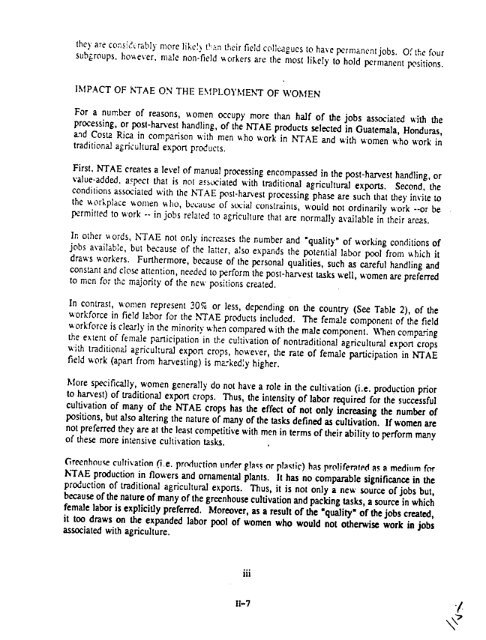MUNZSSInlD - usaid
MUNZSSInlD - usaid
MUNZSSInlD - usaid
You also want an ePaper? Increase the reach of your titles
YUMPU automatically turns print PDFs into web optimized ePapers that Google loves.
theyN are consilc rabl) more 1 e t0!-n their field colik.ues to have permanentjobs. Of the four<br />
subgroups. hoAever. male non-field "orkers are the most likely to hold permanent positions.<br />
IMPACT OF NTAE ON THE EMPLOYMENT OF WOMEN<br />
For a number of reasons, %omen occupy more than half of the jobs associated with the<br />
processing, or post-harvest handling, of the NTAE products selected in Guatemala, Honduras,<br />
and Costa Rica in comparison with men vho work in NTAE and with women who work in<br />
traditional agricultural export products.<br />
First, NTAE creates a level of manual processing encompassed in the post-harvest<br />
value-added,<br />
handling,<br />
aspect that<br />
or<br />
is not associated with traditional agricultural exports.<br />
conditions<br />
Second,<br />
associated<br />
the<br />
with the N'TAE post-harvest processing phase are such<br />
the<br />
that<br />
vkorkplace<br />
the) invite<br />
wkomen<br />
to<br />
Aho, bc4.ause of scx.ial constraints, would not ordinarily<br />
permitted<br />
work<br />
to work<br />
--or be<br />
-- in jobs related to agriculture that are normally available in their areas.<br />
In other m,ords, NTAE not only increases the number and "quality" of working<br />
jobs available,<br />
conditions<br />
but<br />
of<br />
because of the latter, also expands the potential labor pool<br />
draws<br />
from %%hich<br />
workers.<br />
it<br />
Furthermore, because of the personal qualities,<br />
constant<br />
such as<br />
and<br />
careful<br />
close attention,<br />
handling and<br />
needed to perform the post-harvest tasks well, women are<br />
to<br />
preferred<br />
mcn for the majority of the new positions created.<br />
In contrast, women represent 30% or less, depending on the country (See Table 2), of the<br />
workforce in field labor for the NTAE products included. The female component of the field<br />
%orkforce isclearly in the minority when compared %ith the male component. When comparing<br />
the extent of female participation in the cultivation of nontraditional agricultural export crops<br />
with traditional agricultural export crops, however, the rate of female participation in NTAE<br />
field work (apart from harvesting) is ma.ked'y higher.<br />
More specifically, women generally do not have a role in the cultivation (i.e. production prior<br />
to harvest) of traditional export crops. Thus, the intensity of labor required for the successful<br />
cultivation of many of the NTAE crops has the effect of not only increasing the number of<br />
positions, but also altering the nature of many of the tasks defined as cultivation. If women are<br />
not preferred they are at the least competitive with men in terms of their ability to perform many<br />
of these more intensive cultivation tasks. I<br />
Greenhoue cultivation (i.e. production under glas or plastic) has prolifemted as a medium for<br />
I-TAE production in flowers and ornamental plants. It has no comparable significance in the<br />
production of traditional agricultural exports. Thus, it is not only a new source of jobs but,<br />
because of the nature of many of the greenhouse cultivation and packing tasks, a source in which<br />
female labor is explicitly preferred. Moreover, as a result of the "quality" of the jobs created,<br />
it too draws on the expanded labor pool of women who would not otherwise work in jobs<br />
associated with agriculture.<br />
11-7 /<br />
,

















